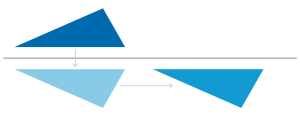History
An early appreciation of the role of motion in geometry was given by Alhazen (965 to 1039). His work "Space and its Nature" [8] uses comparisons of the dimensions of a mobile body to quantify the vacuum of imaginary space. He was criticised by Omar Khayyam who pointed that Aristotle had condemned the use of motion in geometry. [9]
In the 19th century Felix Klein became a proponent of group theory as a means to classify geometries according to their "groups of motions". He proposed using symmetry groups in his Erlangen program, a suggestion that was widely adopted. He noted that every Euclidean congruence is an affine mapping, and each of these is a projective transformation; therefore the group of projectivities contains the group of affine maps, which in turn contains the group of Euclidean congruences. The term motion, shorter than transformation, puts more emphasis on the adjectives: projective, affine, Euclidean. The context was thus expanded, so much that "In topology, the allowed movements are continuous invertible deformations that might be called elastic motions." [10]
The science of kinematics is dedicated to rendering physical motion into expression as mathematical transformation. Frequently the transformation can be written using vector algebra and linear mapping. A simple example is a turn written as a complex number multiplication:  where
where  . Rotation in space is achieved by use of quaternions, and Lorentz transformations of spacetime by use of biquaternions. Early in the 20th century, hypercomplex number systems were examined. Later their automorphism groups led to exceptional groups such as G2.
. Rotation in space is achieved by use of quaternions, and Lorentz transformations of spacetime by use of biquaternions. Early in the 20th century, hypercomplex number systems were examined. Later their automorphism groups led to exceptional groups such as G2.
In the 1890s logicians were reducing the primitive notions of synthetic geometry to an absolute minimum. Giuseppe Peano and Mario Pieri used the expression motion for the congruence of point pairs. Alessandro Padoa celebrated the reduction of primitive notions to merely point and motion in his report to the 1900 International Congress of Philosophy. It was at this congress that Bertrand Russell was exposed to continental logic through Peano. In his book Principles of Mathematics (1903), Russell considered a motion to be a Euclidean isometry that preserves orientation. [11]
In 1914 D. M. Y. Sommerville used the idea of a geometric motion to establish the idea of distance in hyperbolic geometry when he wrote Elements of Non-Euclidean Geometry. [12] He explains:
- By a motion or displacement in the general sense is not meant a change of position of a single point or any bounded figure, but a displacement of the whole space, or, if we are dealing with only two dimensions, of the whole plane. A motion is a transformation which changes each point P into another point P ′ in such a way that distances and angles are unchanged.
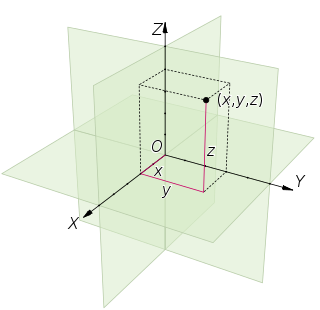
Euclidean space is the fundamental space of geometry, intended to represent physical space. Originally, that is, in Euclid's Elements, it was the three-dimensional space of Euclidean geometry, but in modern mathematics there are Euclidean spaces of any positive integer dimension n, which are called Euclidean n-spaces when one wants to specify their dimension. For n equal to one or two, they are commonly called respectively Euclidean lines and Euclidean planes. The qualifier "Euclidean" is used to distinguish Euclidean spaces from other spaces that were later considered in physics and modern mathematics.

In group theory, the symmetry group of a geometric object is the group of all transformations under which the object is invariant, endowed with the group operation of composition. Such a transformation is an invertible mapping of the ambient space which takes the object to itself, and which preserves all the relevant structure of the object. A frequent notation for the symmetry group of an object X is G = Sym(X).

In Euclidean geometry, an affine transformation or affinity is a geometric transformation that preserves lines and parallelism, but not necessarily Euclidean distances and angles.

In mathematics, hyperbolic geometry is a non-Euclidean geometry. The parallel postulate of Euclidean geometry is replaced with:
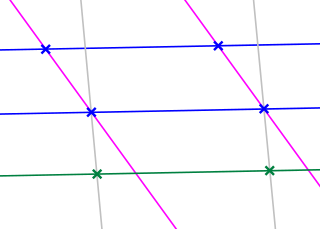
In mathematics, affine geometry is what remains of Euclidean geometry when ignoring the metric notions of distance and angle.

In mathematics, the open unit disk around P, is the set of points whose distance from P is less than 1:
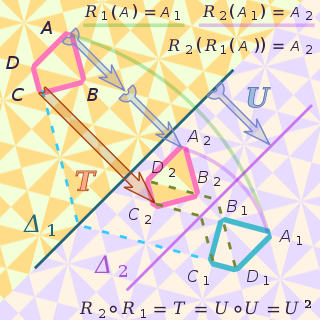
In mathematics, an isometry is a distance-preserving transformation between metric spaces, usually assumed to be bijective. The word isometry is derived from the Ancient Greek: ἴσος isos meaning "equal", and μέτρον metron meaning "measure".
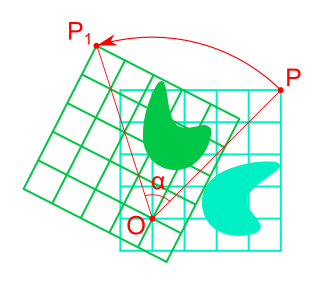
Rotation in mathematics is a concept originating in geometry. Any rotation is a motion of a certain space that preserves at least one point. It can describe, for example, the motion of a rigid body around a fixed point. Rotation can have a sign (as in the sign of an angle): a clockwise rotation is a negative magnitude so a counterclockwise turn has a positive magnitude. A rotation is different from other types of motions: translations, which have no fixed points, and (hyperplane) reflections, each of them having an entire (n − 1)-dimensional flat of fixed points in a n-dimensional space.

In non-Euclidean geometry, the Poincaré half-plane model is the upper half-plane, denoted below as H, together with a metric, the Poincaré metric, that makes it a model of two-dimensional hyperbolic geometry.

In mathematics, a Euclidean group is the group of (Euclidean) isometries of a Euclidean space ; that is, the transformations of that space that preserve the Euclidean distance between any two points (also called Euclidean transformations). The group depends only on the dimension n of the space, and is commonly denoted E(n) or ISO(n).
In mathematics, a Killing vector field, named after Wilhelm Killing, is a vector field on a Riemannian manifold that preserves the metric. Killing fields are the infinitesimal generators of isometries; that is, flows generated by Killing fields are continuous isometries of the manifold. More simply, the flow generates a symmetry, in the sense that moving each point of an object the same distance in the direction of the Killing vector will not distort distances on the object.
In geometry, hyperbolic motions are isometric automorphisms of a hyperbolic space. Under composition of mappings, the hyperbolic motions form a continuous group. This group is said to characterize the hyperbolic space. Such an approach to geometry was cultivated by Felix Klein in his Erlangen program. The idea of reducing geometry to its characteristic group was developed particularly by Mario Pieri in his reduction of the primitive notions of geometry to merely point and motion.
In mathematics, a hyperbolic metric space is a metric space satisfying certain metric relations between points. The definition, introduced by Mikhael Gromov, generalizes the metric properties of classical hyperbolic geometry and of trees. Hyperbolicity is a large-scale property, and is very useful to the study of certain infinite groups called Gromov-hyperbolic groups.

In hyperbolic geometry, a hypercycle, hypercircle or equidistant curve is a curve whose points have the same orthogonal distance from a given straight line.
In geometry, the Beckman–Quarles theorem states that if a transformation of the Euclidean plane or a higher-dimensional Euclidean space preserves unit distances, then it preserves all Euclidean distances. Equivalently, every homomorphism from the unit distance graph of the plane to itself must be an isometry of the plane. The theorem is named after Frank S. Beckman and Donald A. Quarles Jr., who published this result in 1953; it was later rediscovered by other authors and re-proved in multiple ways. Analogous theorems for rational subsets of Euclidean spaces, or for non-Euclidean geometry, are also known.

In geometry, a point reflection is an transformation of affine space in which every point is reflected across a specific fixed point. When dealing with crystal structures and in the physical Sciences the terms inversion symmetry, inversion center or centrosymmetric are more commonly used.

In mathematics, a quasi-isometry is a function between two metric spaces that respects large-scale geometry of these spaces and ignores their small-scale details. Two metric spaces are quasi-isometric if there exists a quasi-isometry between them. The property of being quasi-isometric behaves like an equivalence relation on the class of metric spaces.

In mathematics, a Cayley–Klein metric is a metric on the complement of a fixed quadric in a projective space which is defined using a cross-ratio. The construction originated with Arthur Cayley's essay "On the theory of distance" where he calls the quadric the absolute. The construction was developed in further detail by Felix Klein in papers in 1871 and 1873, and subsequent books and papers. The Cayley–Klein metrics are a unifying idea in geometry since the method is used to provide metrics in hyperbolic geometry, elliptic geometry, and Euclidean geometry. The field of non-Euclidean geometry rests largely on the footing provided by Cayley–Klein metrics.

In mathematics, the Riemann sphere, named after Bernhard Riemann, is a model of the extended complex plane: the complex plane plus one point at infinity. This extended plane represents the extended complex numbers, that is, the complex numbers plus a value for infinity. With the Riemann model, the point is near to very large numbers, just as the point is near to very small numbers.
In geometry, if X is a manifold with an action of a topological group G by analytical diffeomorphisms, the notion of a (G, X)-structure on a topological space is a way to formalise it being locally isomorphic to X with its G-invariant structure; spaces with a (G, X)-structure are always manifolds and are called (G, X)-manifolds. This notion is often used with G being a Lie group and X a homogeneous space for G. Foundational examples are hyperbolic manifolds and affine manifolds.
